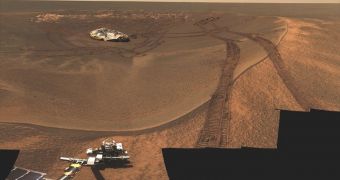Officials at NASA are currently celebrating Opportunity's eight anniversary on the surface of Mars. The event stretches from January 24-25, since the machine arrived at Mars at 21:05 PST, but 12:05 am EST the following day, in 2004.
The spacecraft is the second of two Mars Exploration Rovers (MER), and it landed on the surface of the Red Planet about three weeks after its twin Spirit. The two explorers were deployed to different locations on the planet, and each of them was supposed to function for around 90 days.
However, both MER robots endured for years. Contact with Spirit was lost in 2010, after the rover became embedded in a patch of loose sand called Troy. Subsequent efforts experts at the NASA Jet Propulsion Laboratory (JPL) made to set it free have all failed.
Even so, the rover spent nearly 7 years on the Martian surface, collecting a wealth of data even though it was plagued by numerous technical issues. The same holds true for Opportunity, but the second robot is in a far better condition than its dead sibling.
While Spirit received most of the public and media attention, on account of the fact that it was still operating despite overwhelming technical glitches, Opportunity was always the real workhorse of the MER mission. This is evidenced in the fact that it traveled 21.35 miles (34.4 kilometers) thus far.
Its travels took it from Victoria Crater, the spot where it landed, all the way to Endeavour Crater. The rover reached its secondary destination after driving for nearly three years. Granted, it did make some stops along the way, in order to analyze interesting rocks and sand.
The MER robots were constructed so that they could shed more light on our neighboring planet's distant climate past. Spirit and Opportunity were able to demonstrate the liquid water once flowed on Mars, by analyzing sediments and deposits found at their landing site.
In addition, the two spacecraft were able to study Mars' ancient atmosphere, by studying meteorites they found lying on the ground. Studying how the space rocks melted as they traveled through the air can reveal the chemical composition of the atmosphere at the time of their entry.
“It is amazing. I have to remind myself – my God, this thing is still going! But more importantly, it is still very productive on the surface,” says JPL MER project manager, John Callas, quoted by Space.
He and his team have a secret desire, which is to make Opportunity the record-holder for the longest distance traveled by a rover on an alien world. That record is currently being held by the Lunokhod 2 robot, which traveled 23 miles (37 kilometers) on the surface of the Moon in 1973.

 14 DAY TRIAL //
14 DAY TRIAL //